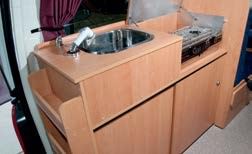Frontline launches new Ford Transit Custom campervan
New Blue Oval base allows Sydney campervan specialist to offer more space and comforts inside
Source: caravancampingsales.com.au
Long-standing Sydney campervan conversion specialist Frontline has ripped the covers of its much-anticipated new Ford Transit Custom camper, at the 2025 NSW Caravan Camping Holiday Supershow at the Rosehill Racecourse in Sydney.
Adding to Frontline’s Toyota Hiace, Volkswagen Transporter and Renault Trafic conversions, the new Frontline-fettled Ford boasts the largest bed area in the Frontline range, along with a big wardrobe, increased kitchen bench space, and an electrical system located in a way that opens up additional storage space in the boot area.
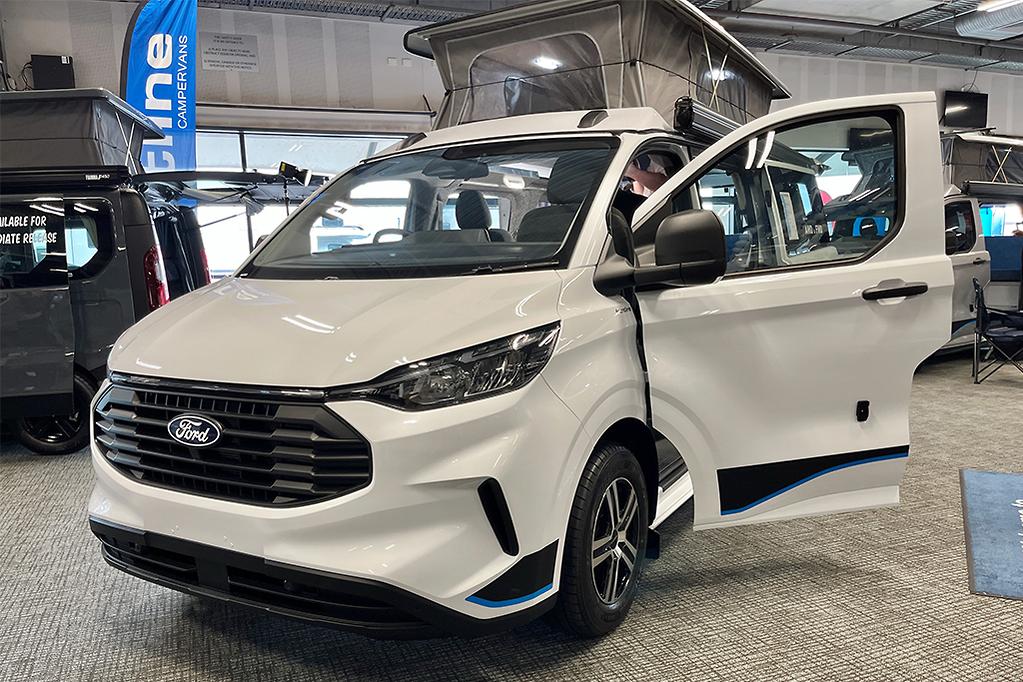
Pricing for the Frontline Ford Transit Custom starts at $110,000 drive-away, based on the Transit Custom Trend model in Frozen White. Four other paint hue choices are available for an additional $3600, while there are numerous other vehicle extras such as a towbar, alloy wheels, and side striping before you get to the fit-out optional extras.

Pricing for the Frontline Ford Transit Custom starts at $110,000 drive-away, based on the Transit Custom Trend model in Frozen White. Four other paint hue choices are available for an additional $3600, while there are numerous other vehicle extras such as a towbar, alloy wheels, and side striping before you get to the fit-out optional extras.

Standard kitchen and cooking features include a stainless steel sink with electric pump, both butane and induction cookers, and a 12-volt 90L fridge-freezer.
The pop-top has three flyscreen windows, and the conversion also includes soft fabric wall lining, fully-lined curtains, 15mm plywood flooring with vinyl coverings, a swivel passenger seat or fixed, front three-seat bench, day-and-night bed/lounge, a swivel table, external shower, 55-litre water tank and a wind-out awning.

The standard fit-out electrical system incorporates a 110Ah AGM battery with Victron 240V charging and DC charging and an Orion DC to DC and MPPT solar regulator. A couple of off-grid lithium/solar set-ups are available as options, while also standard option is a 12-volt fan with a timer and six LED lights.
With a Tare of around 2350kg and a 3225kg GVM, the Frontline camper has a payload of approximately 875kg, to go with its 2500kg towing capacity.

The base vehicle, 2025 Ford Transit Custom, is a fresh-sheet design released in late 2024, and features upgrades to occupant safety and comfort, better cabin and rear area space, and a more versatile and easily accessible cabin.
The powertrain consists of a 125kW/390Nm 2.0-litre turbo-diesel engine, with an eight-speed automatic transmission and front-wheel drive, although Frontline says it will also offer an AWD version.
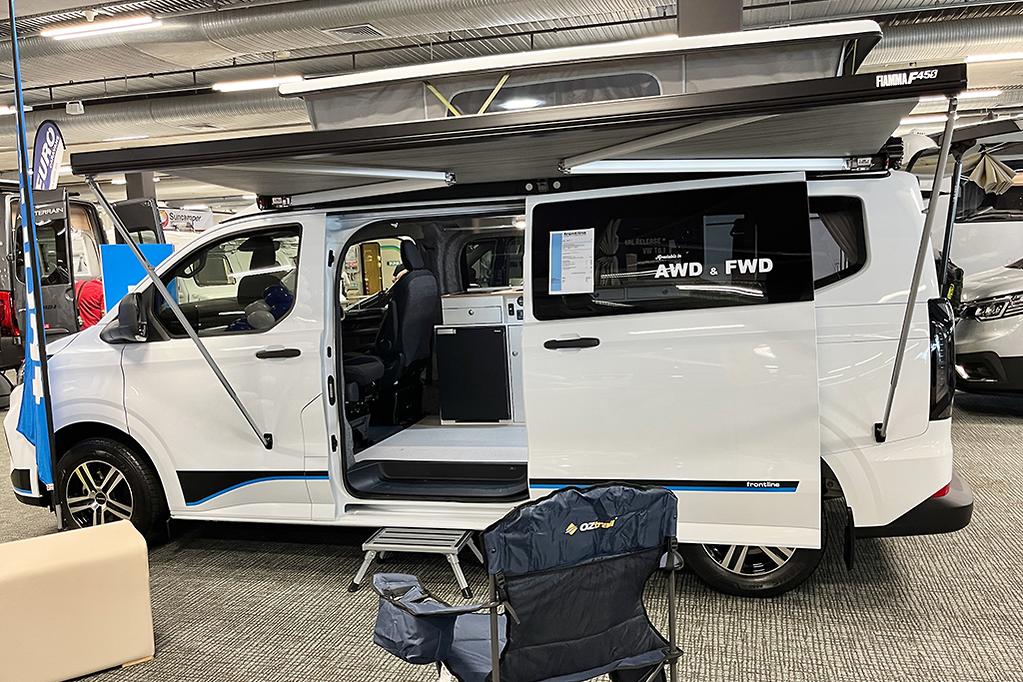
The fit-out includes multiple cabinets, seat trim, and curtain colour and patterns to choose from, while there are numerous extra-cost options to add to the bill. These include flyscreens to the rear or side door, a rear door tent, a microwave, a portable toilet, diesel heating, and lithium battery and solar upgrades.
Like all new Frontline campers, the Transit Custom is fitted out at the Brookvale, NSW factory, and comes with full volume second-stage Federal approval.
Frontline launches Renault campervan
Source: CaravanCampingSales.com.au
Full Article
New Renault Trafic-based campervan from Sydney’s Frontline priced from $96K
Sydney-based campervan conversion specialist Frontline has ripped the covers off an all-new model at this year’s NSW Caravan, Camping and Holiday Supershow.
Joining Frontline’s existing Volkswagen Transporter and Toyota HiAce based models, the new Frontline campervan is based on the latest Renault Trafic commercial van, with choice of either Pro Trafic LWB or Premium Trafic LWB base vehicles and a six-speed manual or six-speed dual-clutch automatic transmission.

Powered by a 125kW/380Nm 2.0-litre turbo-diesel four-cylinder engine, the Renault-based Frontline campervan comes in three layouts: the two seat/two-to-four berth Vacationer which offers full camper walk-through thanks to its unique rear dinette conversion; the four seat/two-to-four berth Adventurer, or a four seater with extra large bed called the Adventurer Full Width.
Like other Frontline campervans, the new 5.48m long x 1.96m wide x 2.065m high Renault camper features a pop-top roof and optional swivelling front passenger seat, and all variants can be fitted with an optional roof bed for the kids.

All layouts feature a front kitchenette that faces the side sliding entry door and incorporates a stainless steel sink with 12V water pump, 75 litre fridge and Butane portable or electric induction cooker.
Other standard features include a tinted sliding window with flyscreen, six LED lights, interior curtains, inside/outside table, day and night bed lounge, Fiamma awning, 100Ah AGM battery system, 50 litre fresh water tank with shower hook-up, 12V fan, storage cupboards and various electrical sockets.
There are a number of options available, including colour matching paint and pop-top, rear and side door screens, a microwave, portable toilet, hot water unit and TV.
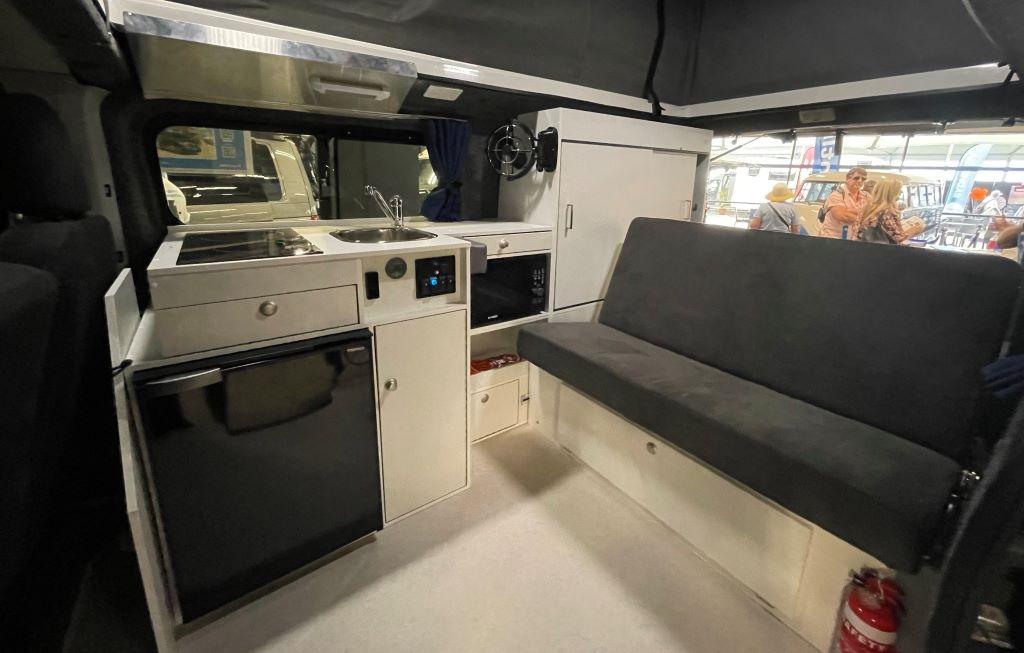
Introduced in late-2022, the latest Renault Trafic medium van offers a more car-like driving experience with an 8.0-inch infotainment interface that incorporates smartphone mirroring, DAB+ digital radio and Bluetooth connectivity.
Safety gear in the new Trafic includes active emergency braking system (AEB), adaptive cruise control, blind spot monitoring, lane departure warning, traffic sign recognition, rear parking sensors and a reversing camera, and automatic high beam for the LED headlights.
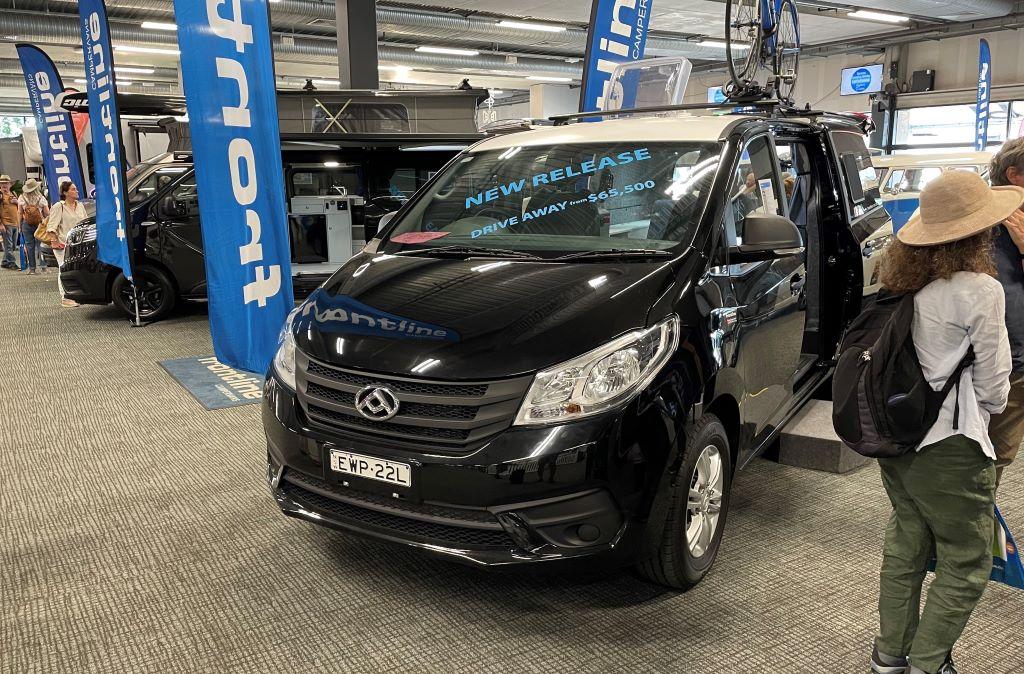
Tare weight of the Renault Frontline campervan is approximately 2300kg with a GVM of 3070kg. The Frontline Renault can also tow up to 2500kg depending on the variant.
Pricing for the new Renault Trafic-based Frontline campervan starts at $96,000.
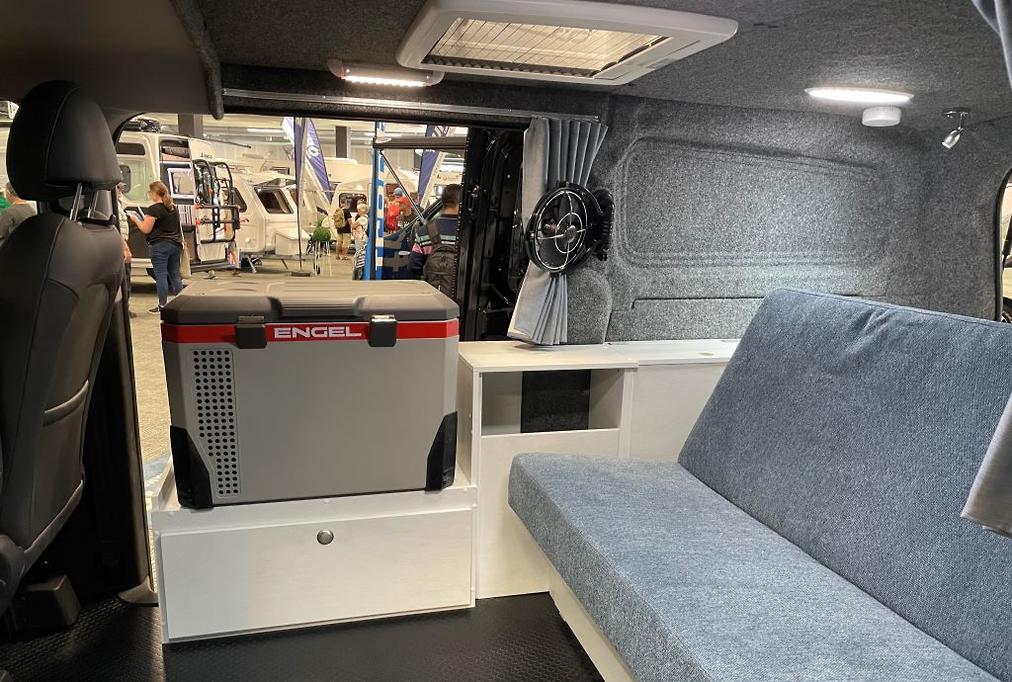
Also on display at the Sydney Supershow was a black metallic prototype of a new entry-level Frontline campervan, based on a Chinese-built LDV G10 panel van.
Priced as displayed was $69,290 with a few options fitted, with the basic fit-out on the new fixed low-roof model including a 38L fridge freezer, day night bed lounge, water tank, pull out shower, 100Ah battery system, butane cooker, and various cupboards, lighting as well as other campervan features.
2023 NSW Caravan Supershow highlights
Source: CaravanCampingSales.com.au
Full Article
Some of the things that caught our eye at Sydney’s biggest caravan show
One of Australia’s biggest caravan shows, the 2023 NSW Caravan, Camping & Holiday Supershow, has kicked off at Rosehill Racecourse and runs for six days (April 18 to 23).
While not quite as jam-packed with exhibits as previous years, the Sydney Supershow still has plenty of the latest RVs and accessories on show with more than 260 displays spread out over the picturesque Rosehill Racecourse grounds and indoor facilities.
Not to mention a few sideshow acts including free daily educational sessions, cooking classes and children’s entertainment. It’s a dog-friendly event too, so no need to leave Fido at home while trying to nab a show bargain.
Here are a few of the highlights of this year’s show…
Two new Frontline campers
Sydney’s Frontline is best known for its Volkswagen and Toyota based campervans, but to broaden its range it’s unveiled two new variants at the Sydney Supershow including a 5.48m campervan based on the latest Renault Trafic commercial van, and another camper based on the Chinese-built LDV G10 panel van.
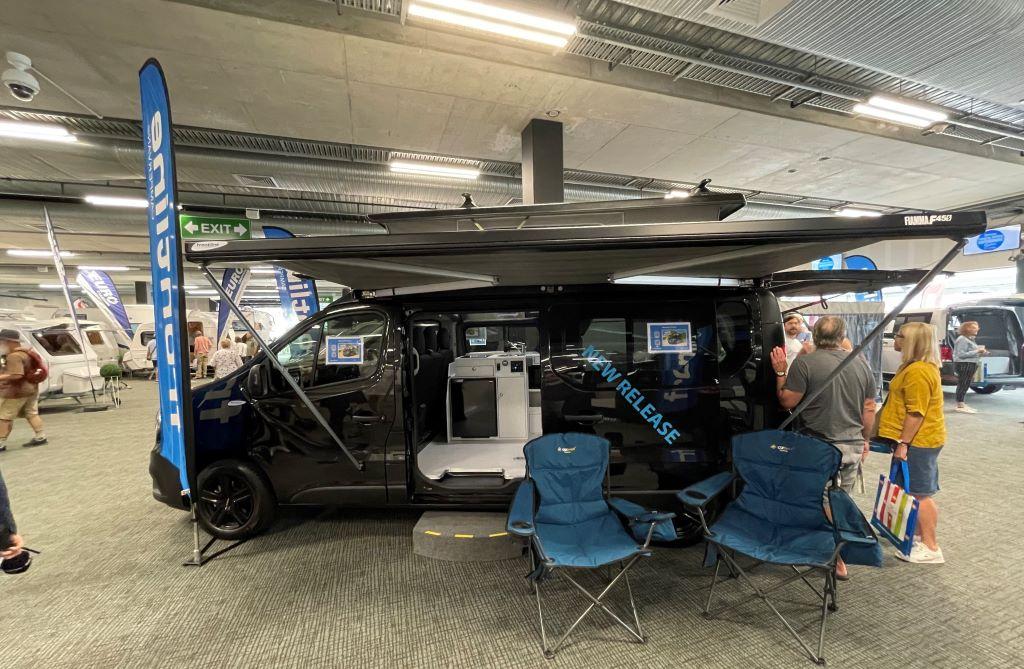
Priced from $96,000, the new Renault camper has a similar spec list and layout options to the Frontline HiAce camper, while the new LDV Frontline camper is pitched more at buyers on tighter budgets with fewer camping and comfort features for its $69,290 starting price.
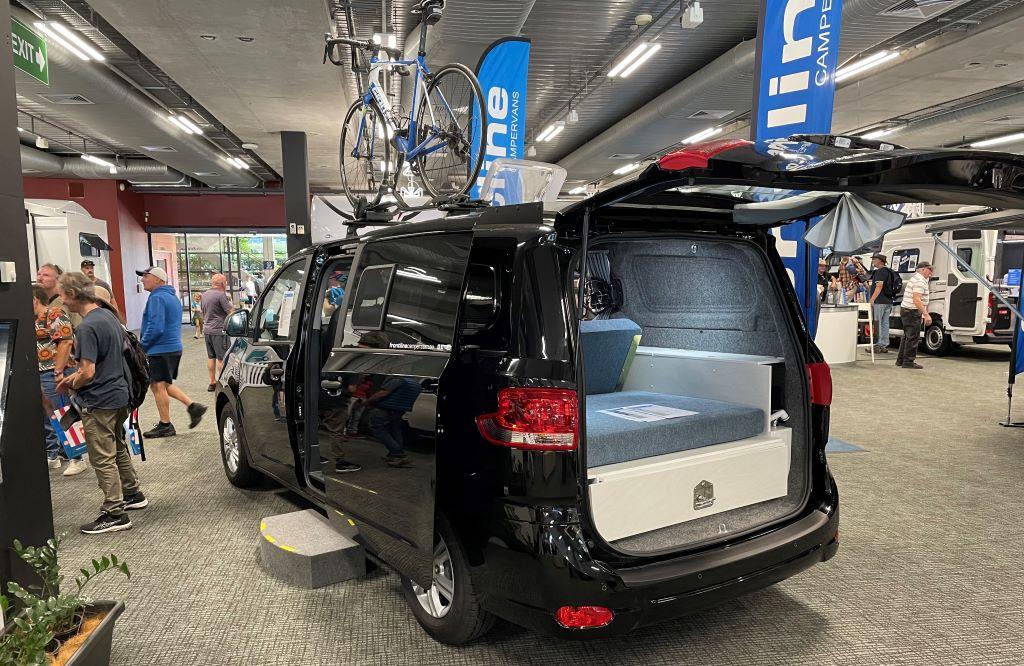
The best five motorhomes under $150k in Australia
Source: RVDaily (View full article here)
With some motorhomes going for half a million dollars in Australia, you’re starting to feel dishearted about getting one for under $150k. Many of us dream of breaking into the RV scene without simultaneously breaking the bank. Fret not! We’re here to assure you that you can jump behind the wheel without having to sell a kidney. This article is for you if your motorhome budget is less than $150k.
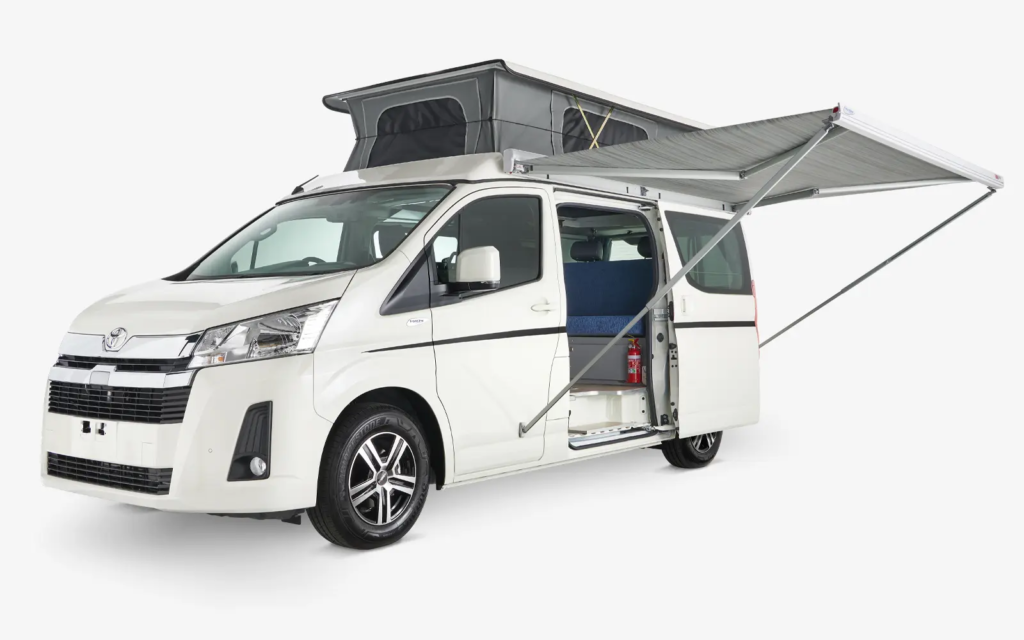
Frontline Toyota Hiace H30 6 Gen
Cost: starting at $88,500
Frontline Camper has again transformed the ever-popular HiAce to create a functional motorhome that is comfortable enough to become your home on wheels for under $150k. The bonneted body style places the engine up front, providing increased front-end collision protection in the event of an accident. Keeping your safety in mind, further improvements have been made, including seven airbags and a 5-star ANCAP rating.
If you need extra help getting into the cabin, a large low step and grab handles make cabin entry easy and accessible. Its clever interior design makes the cabin feel spacious with internal width, allowing you to enjoy your time inside. Fitting in most suburban garages when unused, the Frontline Toyota Hiace H30 6 Gen is versatile enough to be your suburb/city car and your vehicle to your camping spot. Starting from well under $100k, you can choose the best add-ons that will suit your lifestyle and adventures!
Specs
- Travel dimensions: 5.26 (L) x 1.95 (W) x 2.06 (H)
- Tare weight: 2450kg, approximately
- Loading weight: 850kg
- Sleeps: 2 adults (with optional roof bed to sleep 4)
- Internal kitchen

Frontline VW T6.1 Transporter
Cost: from $94,000
You can enjoy the best of both worlds with Frontline’s VW T6.1 Transporter motorhome for under $150k. If you choose your options wisely, this one comes in at under $100k. Whether it’s time to head to the store to do grocery shopping or you’re itching for a camping adventure, the Frontline VW T6.1 Transporter is the perfect vehicle. It’s both an affordable and high-quality campervan and a second car for the family.
Most think of the bed or interior room when it comes to motorhome comfort. But what about the driver? Driver comfort is critical since you spend much time driving to and from destinations. The Frontline VW T6.1 Transporter comes with a leather multi-function steering wheel. There’s also a flexible adjustment for the driver’s seat height and lumbar adjustment.
This motorhome also features an excellent dash layout with storage and long-drive ergonomics. Although prices start at $94,000, the Frontline VW T6.1 Transporter motorhome has more options and accessories for an extra charge to choose from. You can essentially build your motorhome the way you choose and for the price that works best for you, which in this case, is under $150k.
Specs
- Travel dimensions: 5.29 (L) x 1.90 (W) x 2.06 (H)
- Tare weight: 2300kg
- Loading weight: 700kg
- Sleeps: 2 adults (with optional roof bed to sleep 4)
- Internal kitchen
Frontline Toyota HiAce H30 6 Gen Campervan 2022 Review
User-friendly compact campervan is perfect for first-time van lifers
First-time RV buyers have flooded the market since the pandemic started, driven to road-going holiday escapes by repeated lockdowns and local and overseas travel restrictions.
For those new to RV travel, nothing could be easier or safer to drive for long distances than a compact campervan, especially one based on the popular Toyota HiAce medium van, which doesn’t take up much more space on the road than a seven-seat SUV and is just as stress-free to drive and park.
Sydney-based campervan conversion specialist Frontline was one of the first to convert the latest HiAce van and remains one of few specialists in Australia to offer ‘turn key’ production versions of the top-selling Japanese medium van.
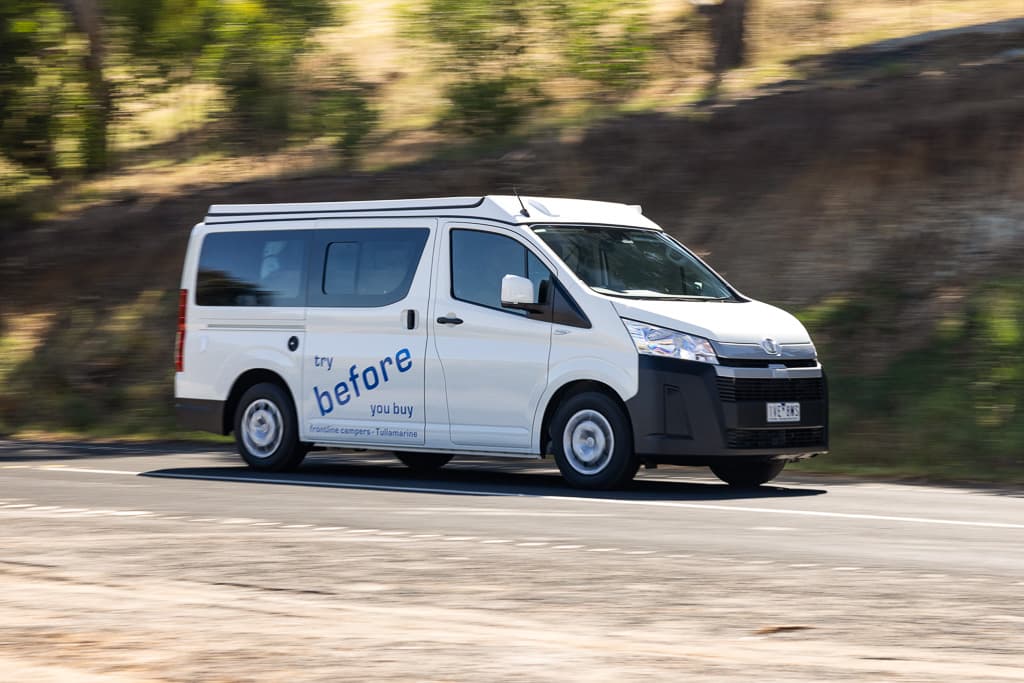
In business for nearly 35 years, Frontline currently builds around three vans a week at its Brookvale factory in north Sydney, based on either HiAce or the slightly more upmarket Volkswagen Transporter.
It also keeps it simple for entry-level campervan buyers, with just a handful of layouts and interior decor options available and a limited number of optional accessories for those who want a bit more comfort or free camping capabilities when touring the countryside.
Ready to roll
Pricing kicks off at $85,500 for Frontline’s HiAce camper, with our ‘try before you buy’ demo vehicle from Frontline’s Melbourne outlet, fitted with the six-speed auto transmission mated to the standard 2.8-litre, four-cylinder turbo-diesel engine, priced at a still reasonable $87,500.

It’s a ‘bog standard’ vehicle, highlighting all the things you get (and don’t get) with a Frontline camper before feeling the need to tick any of the 30-plus option boxes.
“As a van aimed at people just trying out campervanning, we’ve kept this van very simple and haven’t added any options at all,” explained Frontline’s Melbourne manager Jason Magee.
“But it also serves as a great example of the minimum standard inclusions that go into every Frontline camper, even before people look at the options list.”

The review van is fitted out in four-berth ‘Adventurer’ spec — a popular choice among five layouts available — which includes a compact kitchen, external shower and a forward-facing rear bench seat with two seatbelts to go with the driver and passenger front seats.
The rear seating is quickly converted into a double bed at night, and there’s the option of adding a rooftop double bed to turn the van into a somewhat squeezy, four-berth camper.

Our black-bumper review van is based on the cheapest HiAce LWB variant, but you can pay another $1000 for the sleeker GL version with its colour-matched bumpers, door handles, fog lights, and second rear camera.
You can also add side stripes, a front nudge bar and roof racks to jazz up the ‘stealth’ look, although Frontline does an excellent job of retaining the original ‘factory look’ during the camper conversion, including new tinted side windows and a flush-mounted pop-top roof.

SUV-like driving
We weren’t fans of the previous HiAce, cab-over van due to its squishy behind-the-wheel feel, but the latest bonneted version is a big step up in cabin comfort and space, especially for drivers with longer legs.
There’s a clear view out front from the well-cushioned seats, and the rear-drive HiAce impresses with its relatively zippy, refined performance. The 2450kg (unladen) camper gets up to speed quickly in traffic and cruises comfortably on the freeway at 100km/h, thanks to plenty of low-down torque from the diesel engine and smooth, responsive gear changes.

It’s mostly quiet on the move, with the suspension soaking up minor bumps and only the occasional creak or rattle from the living space in the back.
The sharp turning circle makes it easy to squeeze into tight camping spots, with help from the front and rear parking sensors and a reverse camera. Not much larger than the latest LandCruiser, the van’s 2065mm travel height also allows it to slot into the garage at home.
Comfort-wise, the HiAce also boasts a leather steering wheel, air-conditioning, cruise control, and a colour touchscreen with inbuilt sat nav and smartphone mirroring. You also get the reassurance of a five-star safety rating, with disc brakes, seven airbags and vehicle stability control, advancing driving aids like autonomous emergency braking, lane departure warning and a blind spot monitor.

Fuel economy on the trip computer showed around 12L/100km during our test drive, which translates to a theoretical range of about 600km from the 70-litre fuel tank.
Simple set-up
The Frontline HiAce Adventurer also boasts flat-floor, walk-through access from the front seats to the living area, which means you don’t have to go outside to set it up if it’s cold or raining, with the pop-top roof raised from inside.
The main outside entry is through the onside sliding door, or if you’re feeling athletic, you can jump up onto the raised lounge/bed after lifting the top-hinged tailgate. The raised tailgate doubles as another shade cover with the Fiamma wind-out onside awning.

Raising the roof manually from the inside couldn’t be easier after undoing a strap in each corner, and there’s excellent standing room throughout, thanks to the sizeable pop-top roof.
There’s also plenty of natural light and ventilation available thanks to three flyscreen windows in the pop-top canvas and another sliding door and small sliding window on the offside that opens up for more cross-breeze ventilation.
However, you’ll pay more for optional, removable zippered flyscreen panels for the rear tailgate and sliding doors ($380 a pop), which will help keep the bugs out on balmy nights.
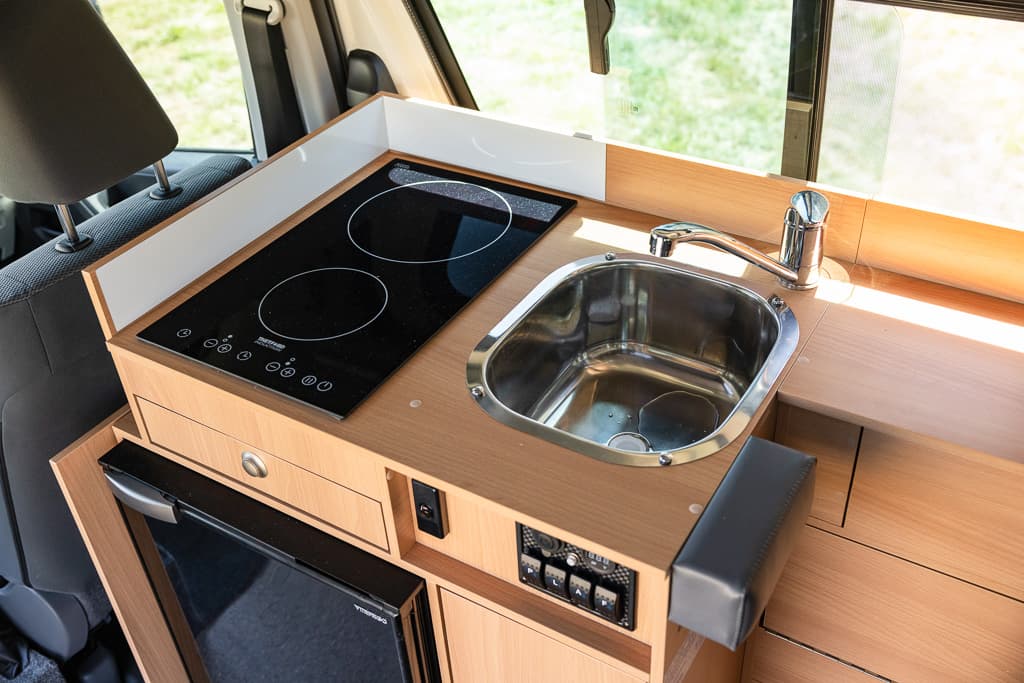
Externally, there’s a socket to plug into 240V power at a caravan park and an inlet to fill the 50-litre fresh water tank. A 22-litre grey water tank is optional.
There’s also a tiny external locker to carry spare bottles for the portable butane cooker that comes standard with the 240V induction cooktop, so you can heat things when free camping. Buyers can opt for a $1500 two-burner gas cooktop instead of the induction cooktop, with the larger gas bottles stored in the boot.
Accessible inside and out, the primary storage space in the rear ‘boot’ is large enough to carry the camp chairs, cords, hoses, a few tools and a portable toilet. Another option is a dedicated under-bed compartment for the porta-Potti, to make it easier to access and use at night.
Camping conveniences
The Frontline camper comes standard with a single 100Ah AGM battery and Victron 12V/15 smart chargers, which are located in the rear boot space, along with a solar regulator and Anderson plug so you can plug in an optional solar panel when off-grid camping.
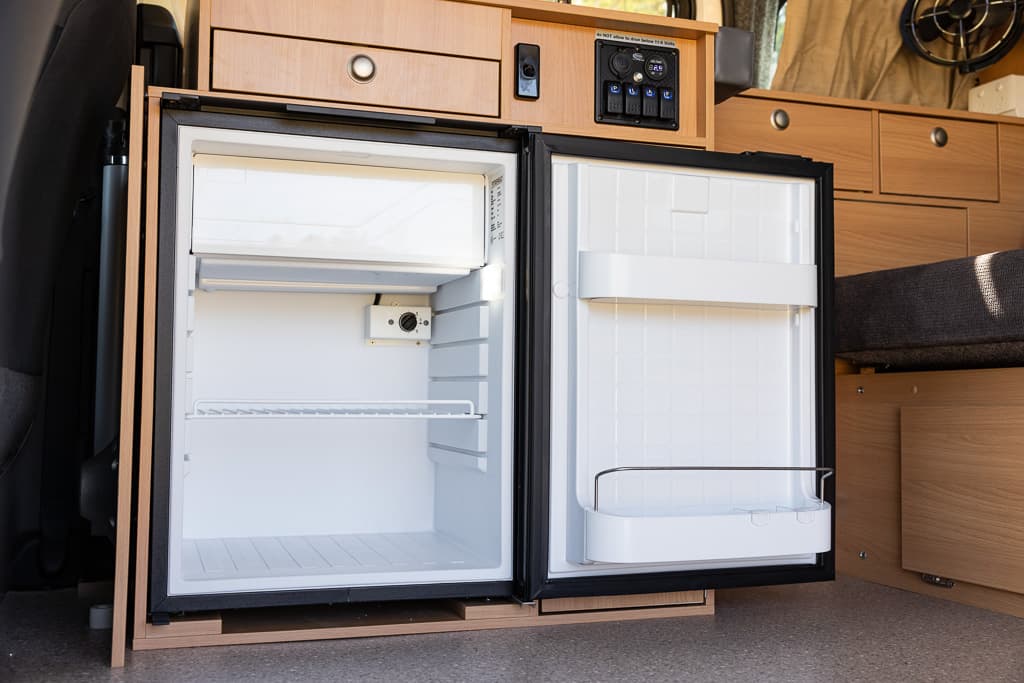
The battery should run the fridge, lights, water pump and fan for a day or two before recharging. You can pay more for another AGM battery or an up to 200Ah lithium battery system and 2000W inverter that will run the induction cooktop outside caravan parks. Still, the bulkier components will eat into valuable storage space in the rear boot.
The compact kitchen has a two-hob induction cooktop and stainless steel sink module behind the driver’s seat, with a 75-litre compressor fridge/freezer below. There’s an aluminium protective shield and light above the cooker, but no rangehood, so you’ll need to open the doors and windows to allow the cooking odours to escape.
For food prep, there’s the option of a narrow strip of benchtop on the right of the sink, an above-cab shelf up front, and a removable dinette table.
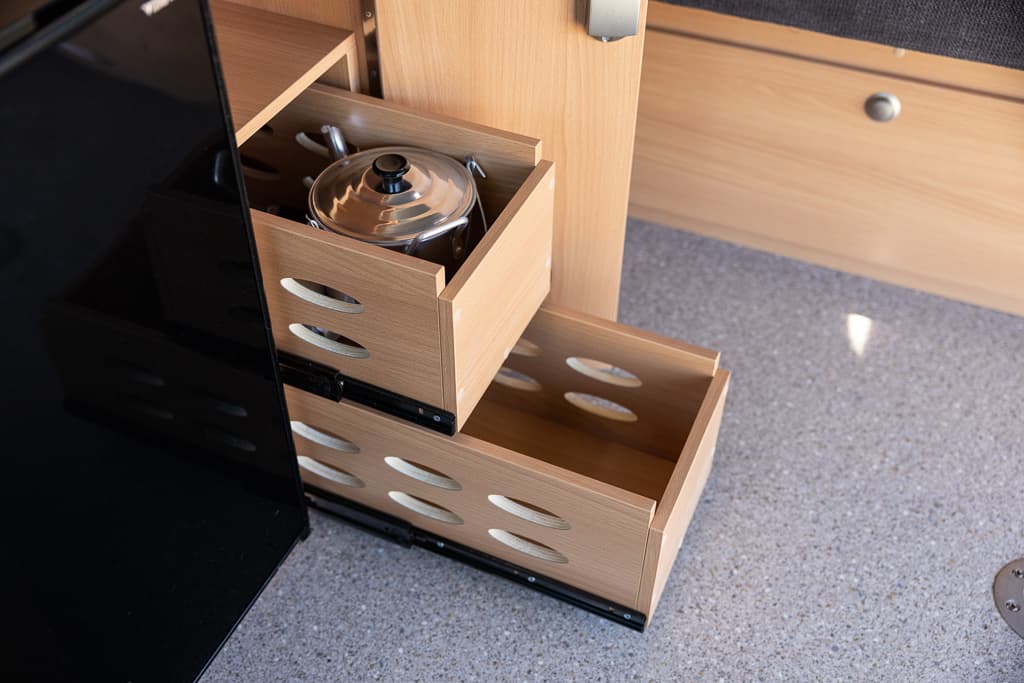
The tabletop and leg are stored behind the driver’s seat and slot easily into place for meals, with further adjustment thanks to a swivel-top and an optional base available to use the table outside. The front passenger seat also swivels around 180 degrees to face the living area when camping.
Pulling a couple of levers quickly converts the ‘Rock and Roll’ lounge/bed into a flat mattress for the night (or day!) use, although you’ll need to store the linen separately when in ‘seating’ mode. The foam cushion bases are comfy, but the 1860mm x 1400mm double bed could be too cosy for two larger adults. If that’s an issue, Frontline offers other layouts with a slightly larger bed.
There’s also the option to slot in a 90kg-rated rooftop bed above the main bed to accommodate a small child or two.
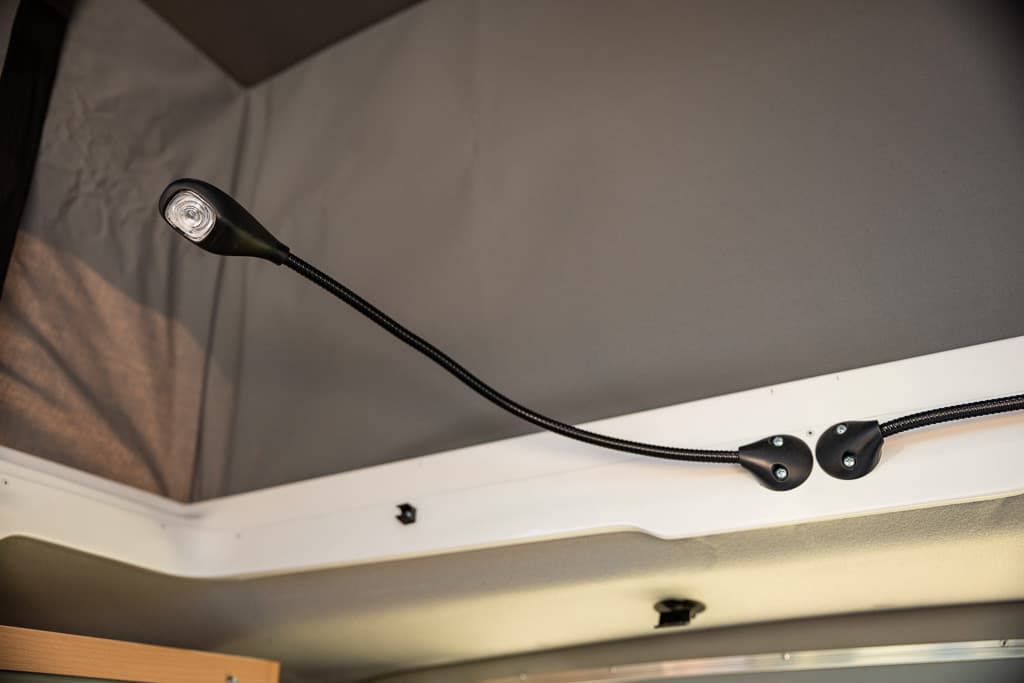
Other on-the-road comforts
Cold showers are outside, using the retractable shower hose with a faucet accessible from under the rear tailgate. If you plan to travel in cooler months, an optional ($2300) 240V heat exchange unit is available for warmer showers.
The interior also has a good array of 240V, 12V and USB sockets for powering a few gadgets, including a 12V socket in the control switch panel located under the kitchen bench. There are also some LED roof lights, flexible stork reading lights, and a single 12V swivel fan.

There are block-out curtains on all windows and the front driving cabin windows, so the swivelled passenger seat remains within the camper space once you’ve closed up for the night.
There’s no option to fit an RV air-conditioner, but buyers can add a diesel space heater, microwave and TV, and canvas outside ‘rooms’, although the more stuff you fit, the less dedicated storage space you’ll have. However, there’s more than enough payload at 850kg, and you can tow a trailer up to 1500kg with the auto transmission.
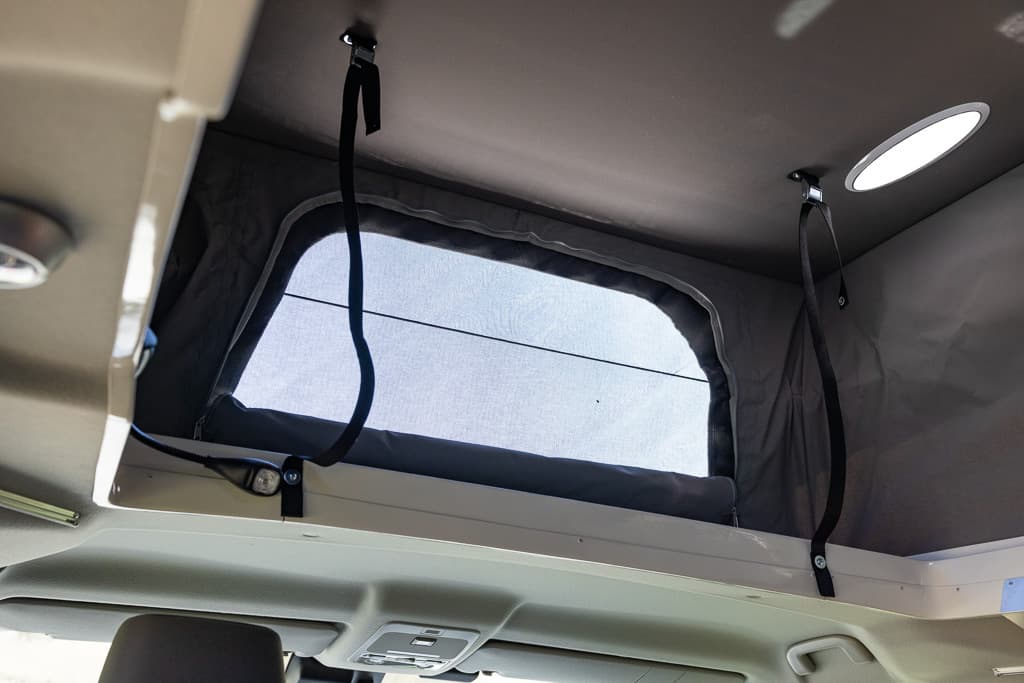
There’s a surprising number of (compact) storage options inside, built into the light ply cabinetry on the offside wall, including six small drawers and cupboards around the kitchen and a good-sized cupboard/wardrobe alongside the bed for clothes and towels.
Frontline offers a limited palette of interior colour options. The review van sporting a more traditional look of beech ply cabinets, Baltic blue cloth upholstery, sand curtains and pebble lino.
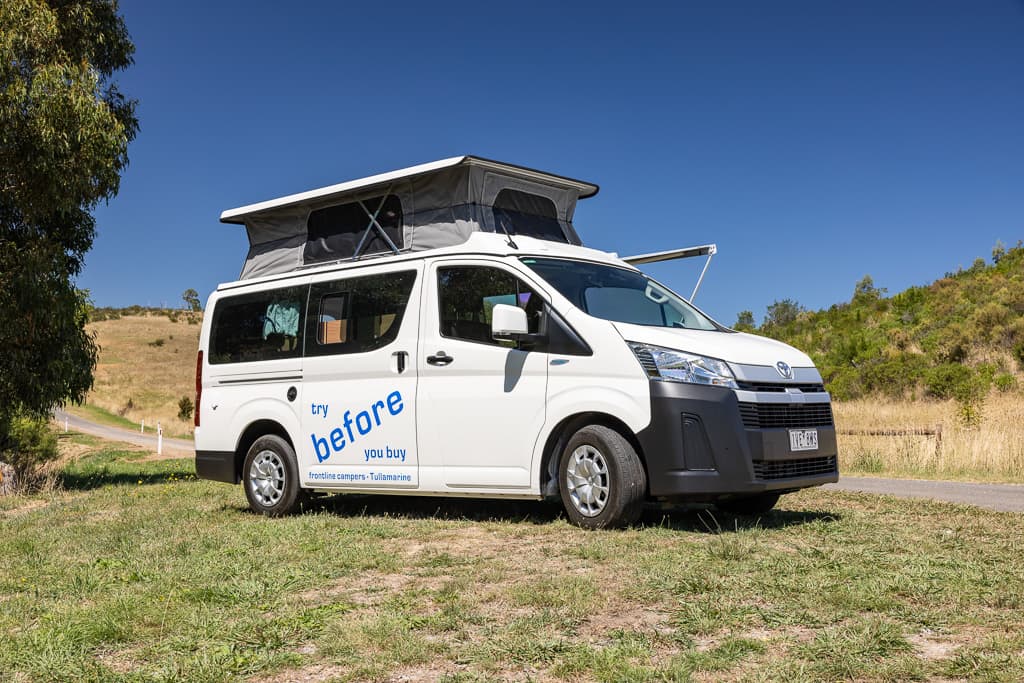
Summing up
While it may lack the ‘bling’ of some of its rivals, the Frontline HiAce Adventurer is hard to fault as a well-designed, practical and user-friendly campervan. It all looks built to last, using lightweight, durable materials, including marine-style carpet and moisture-resistant furniture ply.
Depending on your needs and budget, you might want to add a few options, like hot water and removable fly screens for the entry doors. Still, otherwise, it’s an appealing, affordable entry-level campervan that doubles as a family-friendly daily driver when you’re not on holiday.
How much does the 2002 Frontline HiAce Adventurer cost?
Price: $87,500
Base vehicle: Toyota HiAce LWB Auto
Licence: Car
Tare: 2450kg (approx.)
GVM: 3300kg
Towing capacity: 1500kg
Occupants: Four seatbelts, two berth
Travel length: 5265mm
External body width: 1950mm
Travel height: 2065mm
Interior height: 1970mm
Engine: 2.8-litre four-cylinder turbo-diesel
Power/torque: 130kW/450Nm
Transmission: Six-speed automatic
Fuel tank: 70 litres
Wheels: 16in steel
Brakes: Discs (fr and rr), ABS and ESP
Cooktop: Thetford 240V two hob induction, plus portable butane cooker
Fridge/freezer: Vitrifigo 75-litre compressor
Microwave: Optional
Lighting: 12V LED
Battery: 100Ah AGM and 240V charger
Solar: Portable or rooftop panel optional
TV: Optional
Air-conditioner: NA
Shower: Rear pull-out hose with 12V cold tap
Toilet: Portable optional
Freshwater: 50L
Gas: Optional
Hot water: Optional
Credit: Caravan Camping Sales
https://www.caravancampingsales.com.au/editorial/details/frontline-hiace-2022-review-134626
Explore Nation’s Frontline
KINGS OF THE ROAD: With the easing of Covid restrictions across NSW and broader Australia, there’s never been a better time to hit the road in a Frontline campervan.
AUSTRALIA is a fantastic place, and there’s no better way to explore it than touring in a campervan.
Frontline Campers have been manufacturing Volkswagen Transporter and Toyota HiAcc campervans since 1987. With over 30 years Of knowledge, testing, developing and using the product, Frontline is a name you can trust.
It’s all about getting you to where you want to go in reliable comfort, according to Frontline general manager Tim Heritage.
“When it comes to the vehicle, Frontline works with VW and Toyota HiAce for several practical reasons,” he said. “Both models are easy to drive, boast great safety features, are incredibly comfortable on the road, quickly serviced around Australia and offered excellent fuel consumption and versatility.
“They can be set up as two or four-seater, depending on your needs, and because of their size and specs (both the VW and Hi-Ace are approximately 5.25m long and under 2.1m high), they fit in everywhere around town and yet come the weekend, they’ll take you where you want to go with all the creature comforts. It’s that simplicity and versatility that our customers appreciate.”
Regarding lifestyle, Frontline offers five different layouts that can be customised for your needs.
“The first thing we do is chat about what it is you want to extract from the vehicle in terms of lifestyle,” Tim said. “AII, our vans offer great cooking options, storage and flexible bedding arrangements.
“0ur Volkswagen campervans can be specified as 4-motion all-wheel drive, which appeals to those who
want to explore remotely off-road. The HiAce is more popular with travellers who prefer more road-based familiar touring and getaways.
“A great feature of both is that you can move from front to back of the vehicle inside without having to get out of the car.”
Frontline’s vans appeal to a very broad demographic. “0ur customer base spans from 30-year-olds up to 90 plus – it’s amazing how many younger people are switching onto our campervans. Many of our customers are in that 50-plus bracket looking for a work-life balance.
“They might be stepping back from work with the idea of transitioning to retirement over the next ten years.”
All Frontline campervans come with a three-year warranty, while both vehicles boast five-year unlimited kilometre factory warranties.
Frontline’s headquarters is in Brook-vale, where all the campervans are manufactured, with sales locations in Melbourne servicing the southern section of Australia and Ballina, looking after Northern NSW and beyond.
Frontline Campers was founded by adventure-seeker Peter Farrugia over thirty years ago when he was 21.
“Peter developed campervans that satisfied his outdoors-oriented touring lifestyle based on his experience back then, and Frontline Campers has been sharing his secrets with Australia ever since,” Tim said.
“It’s a point of difference I can’t stress enough in terms of credibility – the level of testing, compliance and experience we offer is unparalleled in the industry.”
With the easing of Covid restrictions across NSW and broader Australia, there’s never been a better time to hit the road.
“It has opened up our options, and I know there are many people keen to get out and support those places that have been doing it tough through bushfires, floods and pandemics,” Tim said.
Credit: Newcastle Herald, Editorial.Challenge.2017
Toyota Hiace Campervan Review by Time to Roam
We’ve been waiting a while, but the new Toyota HiAce campervan from Frontline was worth it.
Toyota knows how to keep a crowd waiting. When the latest HiLux was launched in 2015, it had been 11 years since the last new one. The LandCruiser 200 Series has been on sale since 2008. But the previous HiAce takes the cake — it was on sale for 15 years before being updated late in 2019. It had been around so long only a few campervan manufacturers were still working with the platform. The rest had moved to more modern vehicles like the Hyundai iLoad or tried-and-tested VW Transporter.
But not Frontline. Until the very end, its HiAce camper conversions had found a dedicated market of travellers who didn’t need flash. They just wanted comfortable, dependable and unassuming recreational vehicles that didn’t cost the earth. Now that there is a new HiAce, Frontline has spent the last eight months developing a new range of campers to suit. Over two days exploring the south coast, I checked out the first version, a two-seater with a semi-permanent bed.
Toyota had 15 years of technology and consumer sentiment on safety to consider. The new Toyota HiAce H30 6 Gen Campervan is significantly better than the outgoing model. No more do you sit over the engine and rely on the slimmest of vehicle crumple zones for safety. With the engine out the front and a slew of other upgrades, the new van attained a five-star ANCAP safety rating (the current VW Transporter — the T6 — hasn’t been tested, but the T5 was rated four stars). But it’s more than just a bit of extra cushioning. Each Hiace comes with seven airbags for the two front passengers, a pre-collision safety system capable of hitting the brakes if you fail to, blind-spot monitoring and even a road sign recognition function that warns you if you’ve gone past a sign faster than it indicates. A friendly voice reminds you to obey local road regulations. Above that, the model I tested has an active lane-keeping function that turns the vehicle back into its lane if I let it drift out. It feels like getting hit by a gust of wind, but it works.
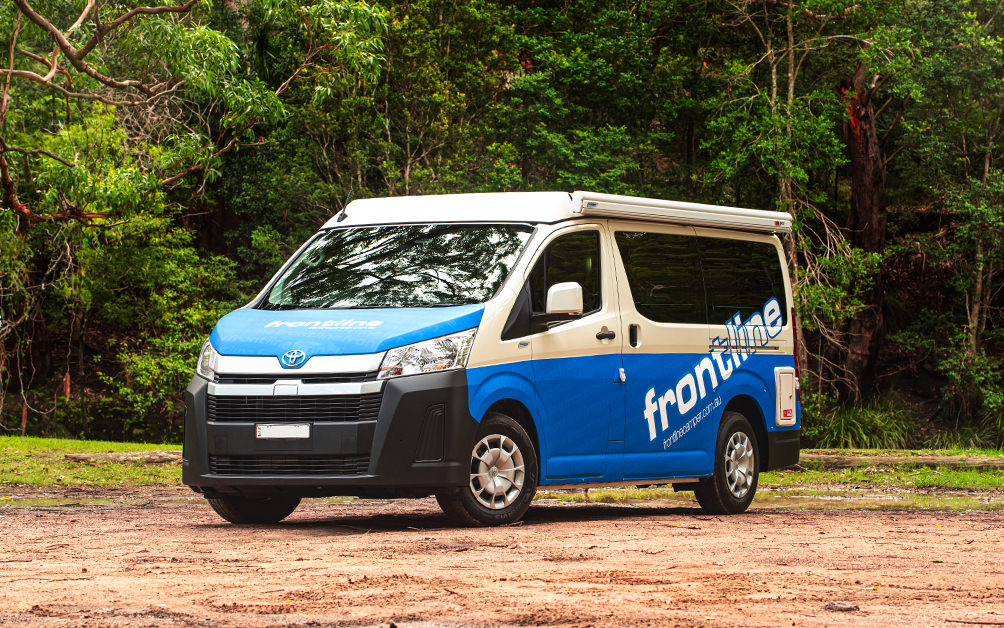

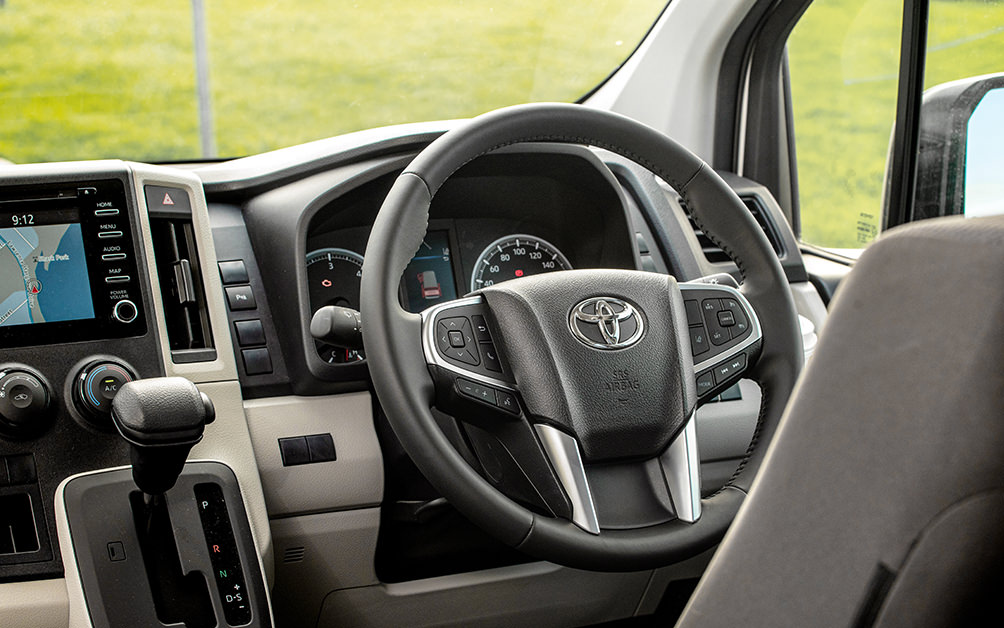
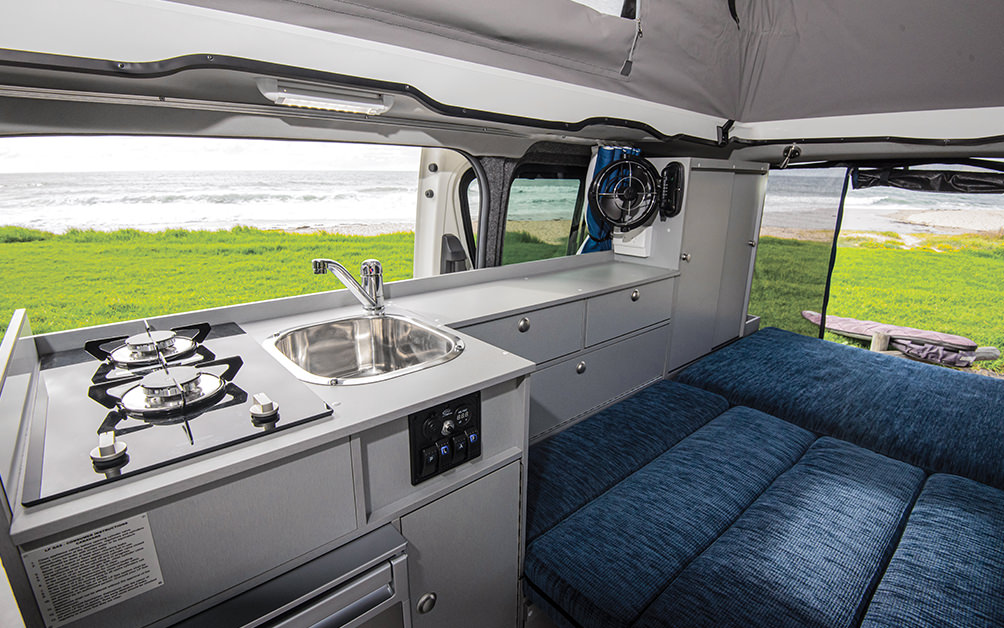
There are two engine options available; a 3.5-litre V6 with 207kW and 360Nm, or the same 2.8-litre found in the HiLux, which produces 130kW and 450Nm.
The latter is expected to be the more popular option, and paired with a six-speed auto, is what I’m testing. It used just less than 11L/100km while I had it.
To drive, it’s pretty good, especially compared to the older commercial model. In the cabin, it’s quiet and smooth, and a modern dash and steering wheel puts everything within easy-to-use reach. As for comfort, VW still has a slight edge, especially in the seats, but the gap has significantly narrowed.
But we’re here for the camping, so what’s the conversion like? Frontline has made many changes with the new vehicle, mainly because the van is slightly shorter but broader in the load area. It also has a walk-through cabin and a narrower entry through the sliding door.
Popping the top is as simple as it’s ever been. All the catches are inside, so you don’t have to go outside to make it happen. Once they’re undone from the interior shelter, a simple push opens it all up. It might not seem like much, but Frontline spent months developing just this part of the van.
Because you can walk from the driver’s cabin into the living area of the van, and the front passenger seat swivels, the new camper is much more spacious than previous Frontline Hiace campers I’ve tested. That front seat is easily the best place to relax, but it also means there’s more room to shuffle around as you cook in the kitchen or hop in and out of the van.
The kitchen is a significant change for Frontline.
For a long time, its vans used a methylated spirit stove in a drawer, which could be quickly taken out for cooking outside. When Dometic stopped making them last year, Frontline moved to a high-quality, two-burner butane stove for that portability but has fitted a Truma two-burner gas hob in the HiAce, set into the benchtop. We can vouch for the furnace — we’ve got the same held in our old Viscount, and it’s certainly a more elegant, easier-to-use solution than metho or expensive butane canisters ever were. The fridge is also new. Frontline’s traditionally fitted Engel upright fridge-freezers to its vans, but the move to Dometic’s 80-litre upright is good. I’ve always found them reliable, high-quality units, which don’t make as much noise when they cycle at night as the Engels do.
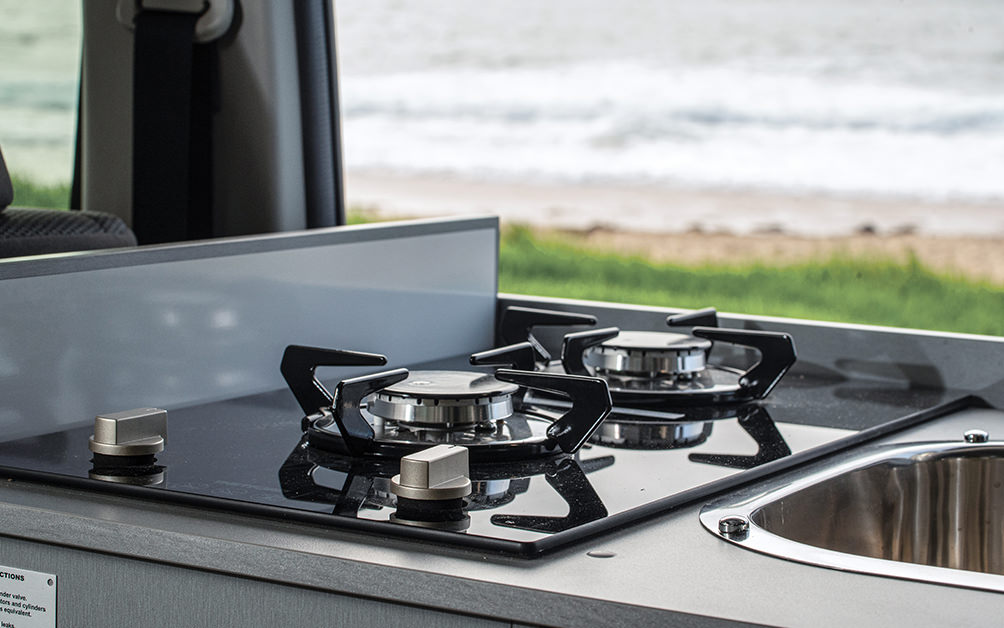

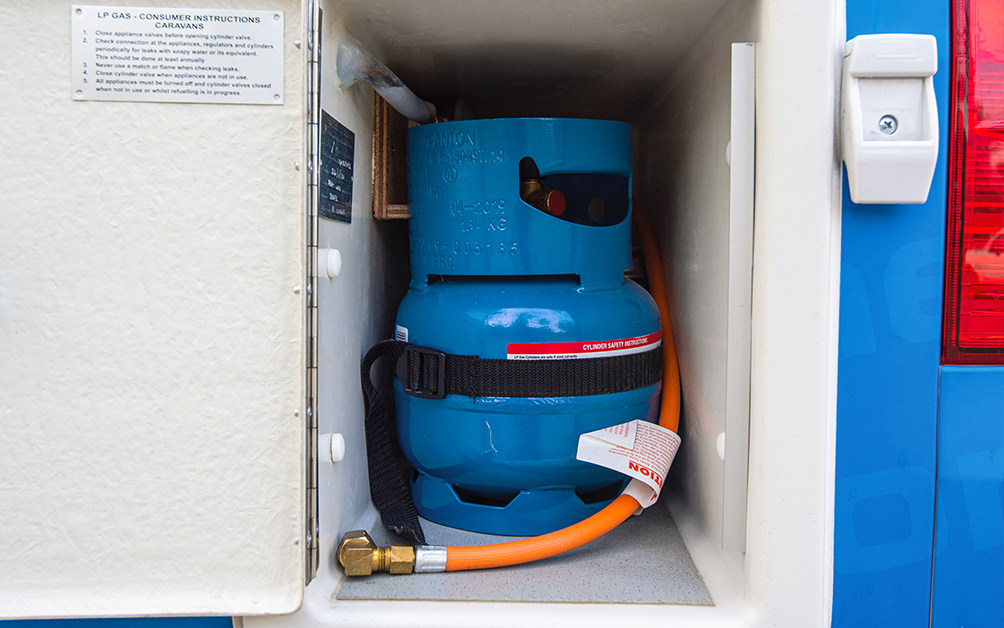
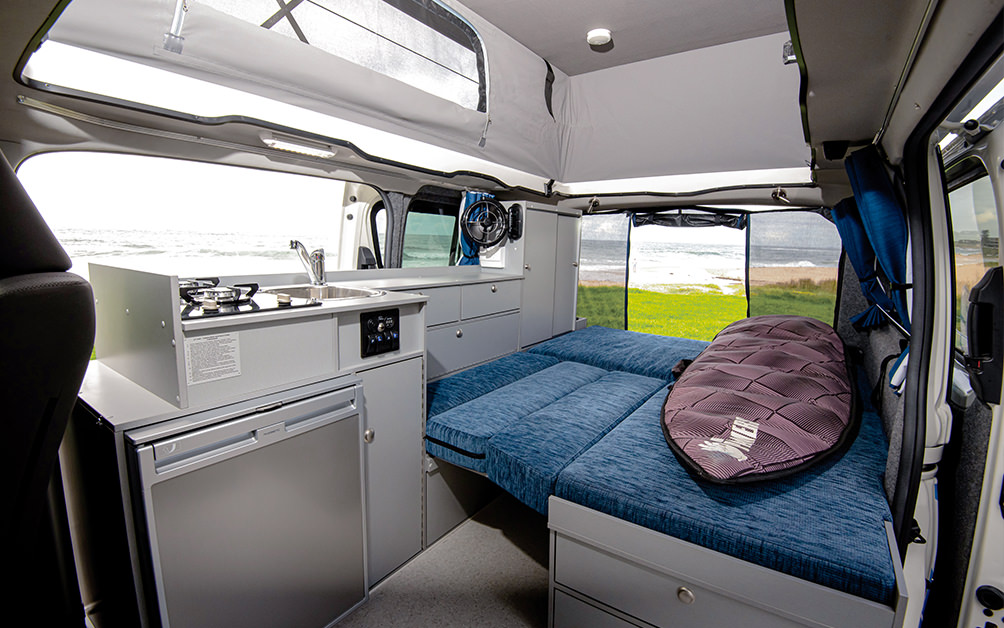
Typically for Frontline, the storage around the kitchen is excellent, with just about every available space used for drawers, cabinets or hidey-hole.
It’s here you get to appreciate Frontline’s cabinetry work as it’s just behind the driver’s seat, but there was no squeak, rattle or annoying noise from it when I drove. The only noise from the back was the occasional slap of a curtain on the driver’s side sliding door, which I could have fixed if it was an issue. I did like that there’s a sliding door on each side, as opening it up behind the kitchen helped get a breeze through, not to mention the view.
The camper’s bed is an evolution of Frontline’s ‘Avalon’ layout, where the bed converts to a club-style lounge with a table that can sit in the middle. Given that the van is so much more expansive, it’s allowed the fitment of an extra cabinet down the side, seen in former Vacationer and Adventurer models. Keeping it all very simple, the table and an extra timber square are all needed to fill the gap to make a bed. And the ample, flat space is much longer than I’ve managed to make it seem in the pictures (it’s at least 6’4″ because that’s how long my surfboard cover is.
There’s plenty of storage under the rear bed. Two drawers slide out neatly into the main entryway while various cushions lift to reveal more cabinets underneath. The back half of the bed sits over a boot, the largest dedicated storage area in the van. It’s big enough for camp chairs, extra awning walls or other bulky gear.
Although simplicity is evident throughout the camper, it’s still fitted with all modern needs.
A 100Ah battery sits under the bed, charged automatically when driving. It can be expanded to a second battery or with solar panels on the roof. Frontline specifies a 50-litre water tank, but hot water is only an option. That’s because hot water tanks are bulky and take 20 minutes to heat up, whereas you have to bring a kettle anyway. All the lights through the camper are LED, and there are USB charging points at the kitchen, along with 240-volt outlets for when you have power, At the back, there’s a cold-water shower, perfect for rinsing things off.
Overall, this is a great new camper. Too good, almost. For a few thousand dollars less, you can get a Frontline converted Volkswagen Transporter with the little, 103kW engine. Unless you wanted a specific layout that’s not yet available in the HiAce, there’s no way you’d bother. Even the more expensive 132kW VW doesn’t look quite the value this new model does. The safety, comfort, drive and layout of the new Toyota are just so good now that it’s a close game. For me, unless I needed AWD, I think the van from Japan is the best value camper in the range.
THE BASIC FEATURES
Frontline Toyota Hiace 6th Gen
CHASSIS
Vehicle — Toyota HiAce
Engine — 2.8-litre, turbo diesel
Transmission — 6-speed automated
Power — 130kW
Torque— 450Nm
Fuel Economy — Around 11L/100km
DIMENSIONS AND WEIGHTS
Length — 5265mm
Width — 1950mm
Height — 2065mm
Headroom — 1970mm
GVM — 3300kg
Towing — 1900kg
CAPACITIES
Water — 50L
Grey Water — Optional
Fridge — Dometic, 80 litres, compressor
Battery — 1 x 100Ah AGM
Fuel — 70L
WARRANTY
Toyota —5 years, 160,000km
Frontline conversion — 2 years
From $72,000 drive-away. As tested
(diesel, auto) from $78,000 drive away.
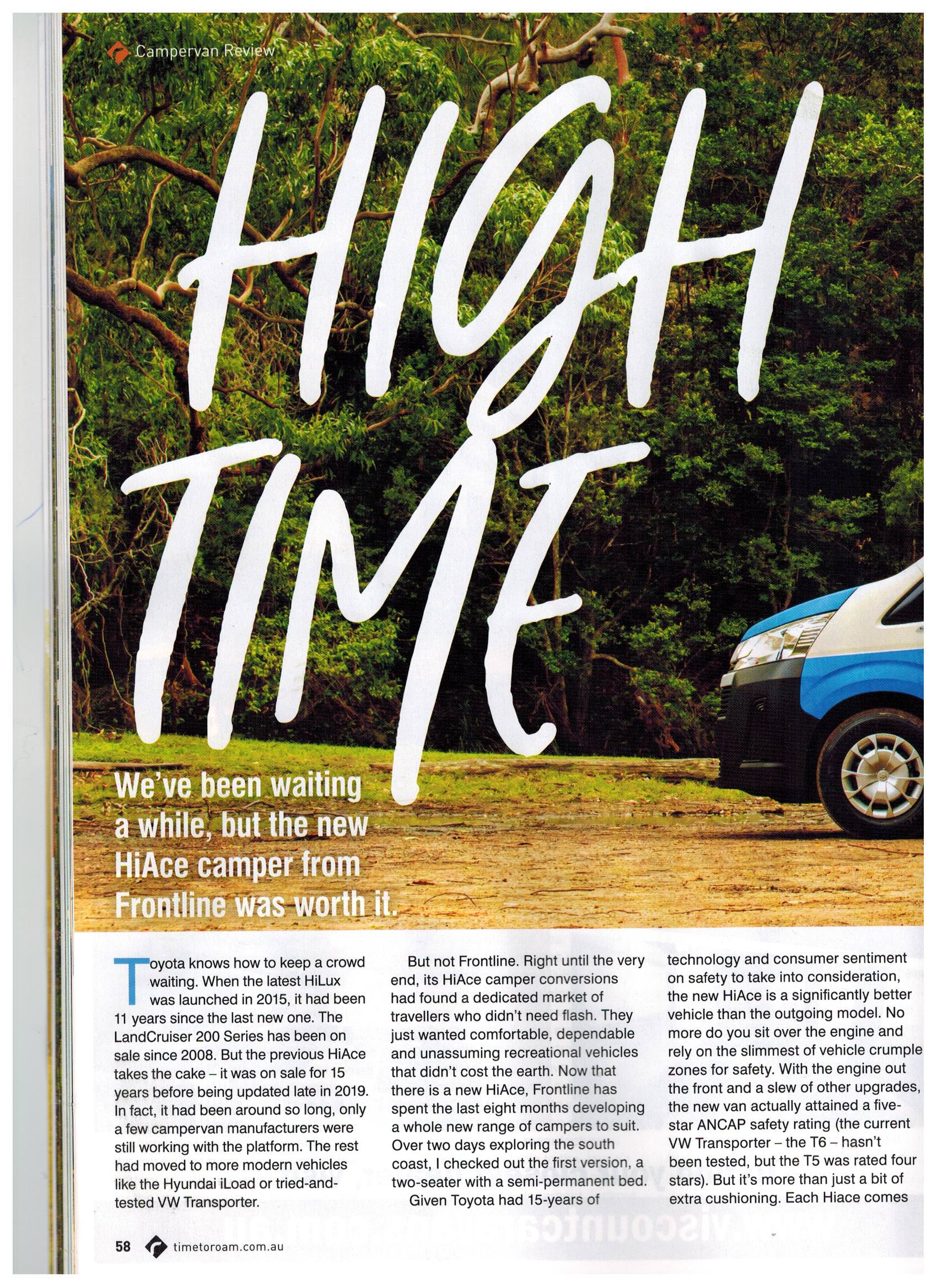


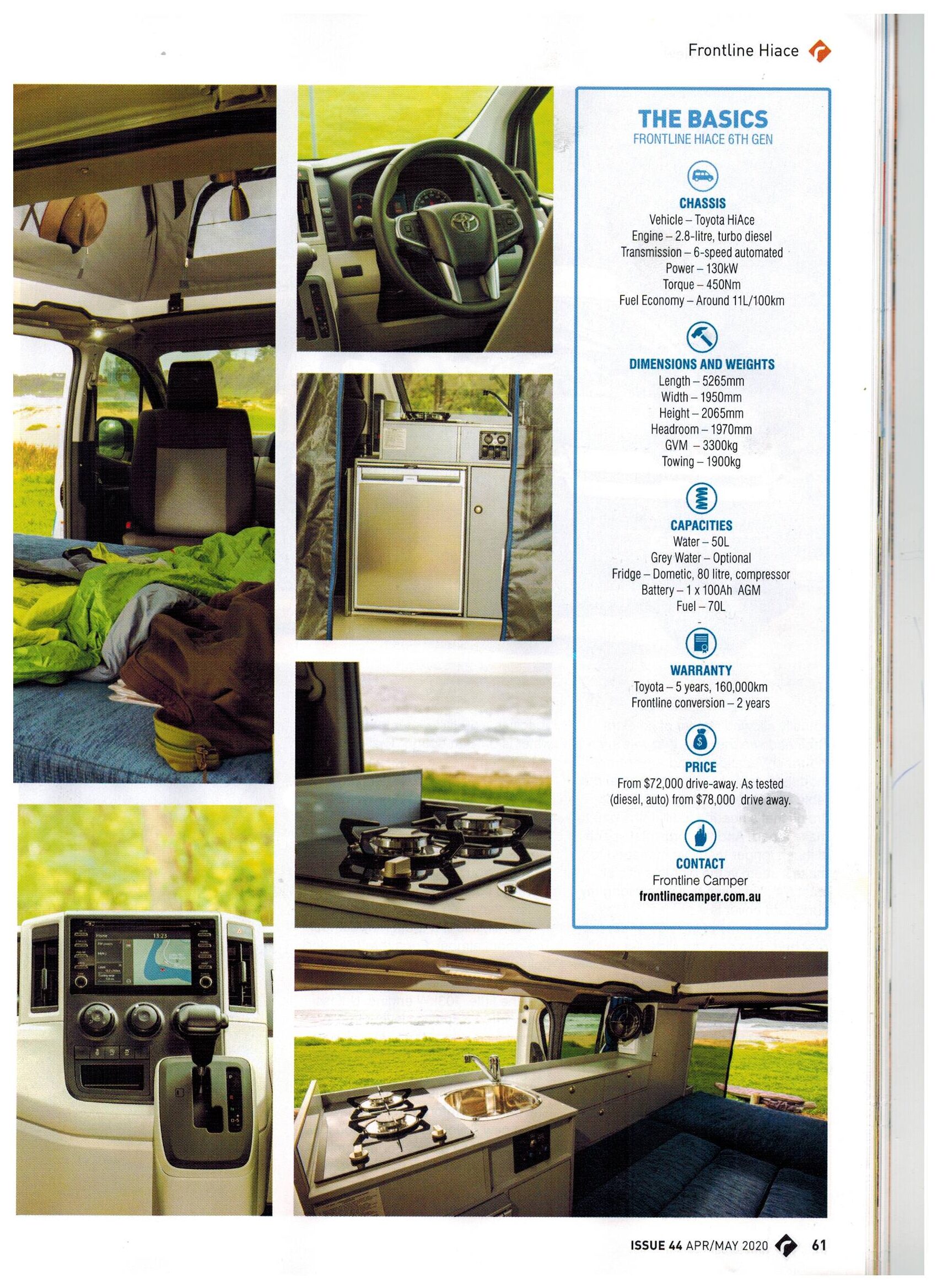
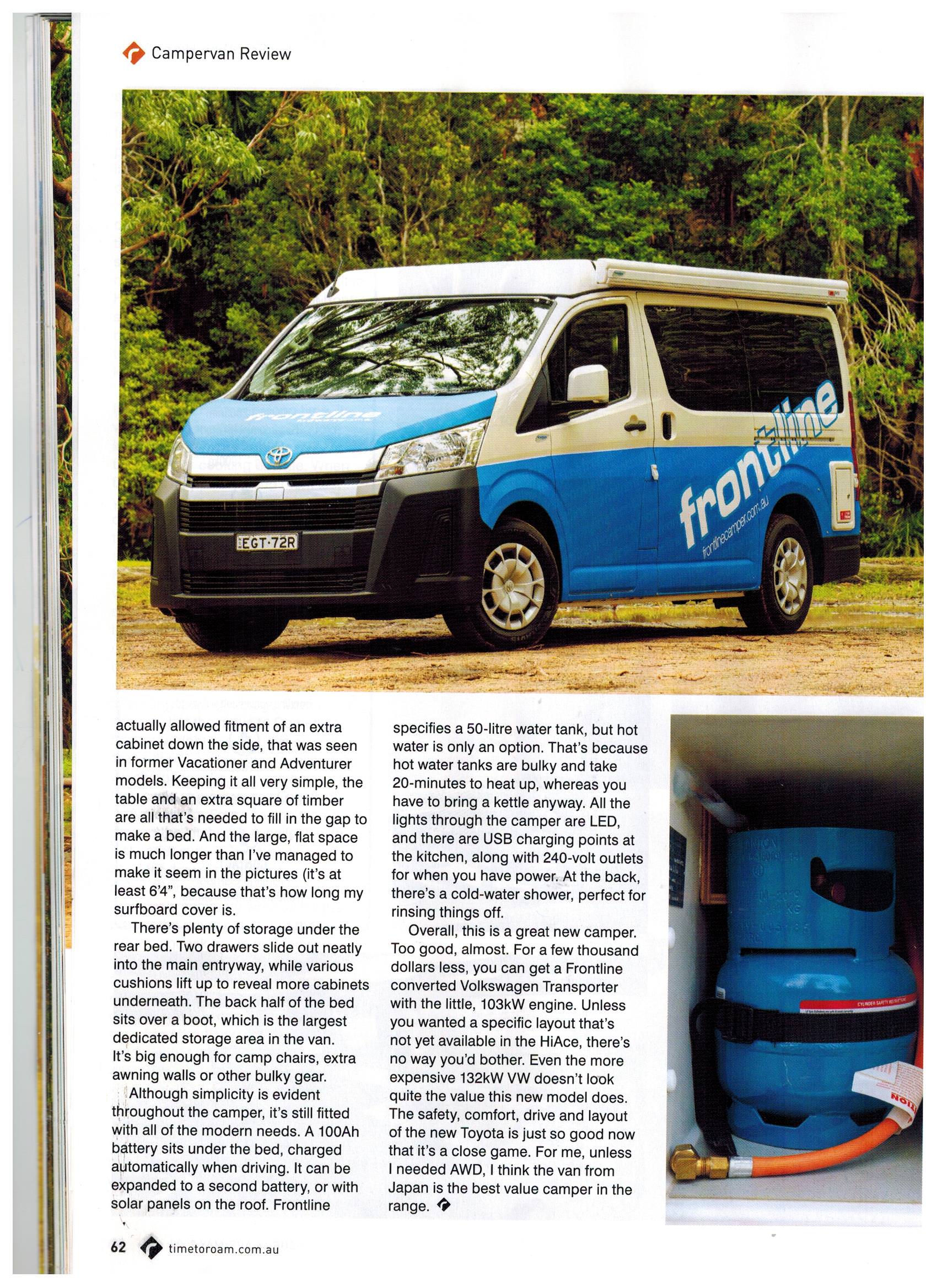
Credit: Time to Roam
New Showroom New Factory
2016 was a hectic year for Frontline with the launch of a larger factory at Brookvale in July.
This new area allows us to have a more significant number of vans on the production floor at any time. This investment has improved efficiency due to a larger workspace, more parts storage and general modernisation of space and equipment. This area also offers a bright, fresh factory for our fantastic team of builders.
New Frontline Showroom
September 2016 was the opening of a more extensive showroom in Brookvale. This area was previously used for manufacturing all frontlines. This has now been converted into a great display area 3 times larger than the previous showroom. This gives customers an all-weather undercover area to view our great Frontline products. We can display up to 14 new campers inside, ready for purchase, with additional space. Additionally, we can display awnings, attachable rooms and a range of colours and accessories to improve your knowledge of our products. Both our sales staff are trade qualified and have previous experience building the frontline product. This means passion and product knowledge is second to none. During your visit, we will show you through the product range, carefully explaining the benefits and features of the frontline campers. While here, we will take notes and present a detailed quote for you to take away and consider your next step. We respect the fact that you may be considering other types of products or companies, so this process is handled without pressure hope you will make a return visit and purchase.
So if a new Toyota Hiace or VW T6 campervan is on your mind, why not visit, we have the best display in the country.
Showroom trading hours are 8 – 4.30 pm Monday to Thurs, Friday 8 – 3.30 pm
We are open most Saturdays from 9 am-2 pm for your convenience.
Closed some Saturdays during trade shows and long weekends.
Time to Roam Australia April-May 2015 Issue
When Leonardo da Vinci penned, ‘Simplicity was the ultimate sophistication’ 500 years ago, could he have had the foresight to be referring to Frontline’s 2015 Toyota Hiace campervan?
Probably not. But Frontline has well and truly weaved its customised magic to make the latest Hiace conversion shine. The Sydney company specialising in Hiace conversions since 1987 has turned the 2015 Hiace into something beautiful in its simplicity but well beyond a standard camper.
The fuel-injected 2.7-litre petrol engine never misses a beat. On the open freeway, the Toyota sat comfortably on the 110 km/h speed limit, urging me to put my foot down even further. When I took the back road to the hinterland, the Hiace came into its own. The light yet powerful vehicle loved the challenging winding roads.
The responsive motor is tucked into a simple yet comfortable driving setup, so I thought I was throwing a standard vehicle
around those bends rather than a four-and-a-half-metre-long van. It left me pondering what was capable of the optional 3-litre diesel model or the 2015 six-speed auto petrol model.
When it was time for a rest, setting up camping mode couldn’t have been easier. In no time, I chose a pleasant riverside spot and got to work. The simplicity of the side awning and the rear tailgate offer plenty of shade and weather protection. The optional canvas/flyscreen room to suit the standard Fiamma awning instantly doubled the size of my lodgings; mozzie-proof, sunproof and waterproof.
The kitchen setup is also straightforward. The two-burner stove is removable for alfresco cooking or cleaning, and the sink, ample cupboard, and storage spaces are well thought out. The 80-litre fridge/freezer and the optional microwave oven are perfectly slotted into the kitchen, offering great cooking space.
My only regret at this point was not having a few friends with me to enjoy the generous seating arrangements of the versatile four-seater. The compact dining table offers convenience and ease of setup, allowing for the comfortable option of a fully prepared meal.
In all, Frontline offers six clever options for the internal layout of the new Hiace, so there’s sure to be one to suit most buyers’ needs.
The electrics of the 2015 Hiace are foolproof. The auxiliary battery is charged by the engine or plugged into 240-volt mains. The battery can run the vehicle’s numerous appliances for up to two days without charge. There is also a solar-powered backup option for more remote trips.
The Hiace stereo was up to speed with modern connections available for my iPod. Nothing too fancy, but safe. The sweet tunes led to me effortlessly setting up the comfy double bed for a quick energy-recharging afternoon siesta. Plenty of room and plenty of ventilation for a good night’s sleep. The internal height with the top-popped offered 1910mm head height – reasonable for even a lanky traveller. A roof bed in this space is perfect for an extra bed for a teenager or two kids.
Talking to a Frontline Hiace camper owner who turned up at the campsite later in the day and was only too willing to sing its praises convinced me of their value and versatility.
“Mate, I can fit my surfboards in easily, load up my wife and her artwork, and we can disappear down the coast for a few days trouble-free. All the modern cons,” he said with a smile. “And on the way home, we can park easily around town and stop in to do some errands. Cleaning the van after a road trip is a breeze.”
Over the years, Frontline has converted thousands of campervans, and the 2015 Toyota Hiace conversion comes with a good list of standard inclusions. The optional extras are also reasonably priced, making it affordable to put together a package that meets your needs but won’t cost you an arm and a leg.
In summary, the Frontline 2015 Hiace Campervan is an excellent RV. Smart, simple and when you look at the base price for a Hiace van alone, it’s exceptional value for money.
The sophistication this vehicle embraces through simplicity, reliability and comfort is everything the weekender or extended tourer expects in a campervan, plus a lot more.
Specifications
Body length: 4695mm
Body width: 1695mm
Body height: 2040mm Internal height: 1910mm
Tare weight: 2000 approx
Features
• Power steering
• Air conditioning
• Dual airbags
• Central door locking
• Power windows and mirrors
• AM/FM/CD/MP/USB Bluetooth
• Fuel tank 70L
• Adjustable steering
• Rear-wheel drive
• Engine immobiliser
• 3 year 100kms warranty
• Cruise control
• Steering wheel controls
• Reverse camera
• Pull out cup holders
• Centre console box
Engine Standard
• 2.7L petrol VVT-i inline DOHC
• 6-speed auto also available
• 111Kw 241Nm @ 3800rpm
• Anti-locking brakes
Engine Options
• 3L diesel turbo intercooler
• 16 valve DOHC
• 100kW 300Nm @ 1200 – 1600rpm
Optional
• Automatic transmission
• Coloured paint
The Caravan and RV Magazine – June/July 2012 Issue
THE VAN
The Toyota HiAce Campervan, in its current guise, has been around since 2005, and there’s a good reason it stands alongside the VW T5 Transporter as the most popular small van for camper conversions. The petrol version, a 2.7-litre four-cylinder, produces 111kW, which surprised me on our short test drive. It typically feels Toyota – incredibly reliable if a bit boring – but the seating position and dash layout are not what you’d expect from a van; it doesn’t feel like you’re driving a bus. There is only forward, backward and backrest adjustment on the seats, but they are comfortable, although a little flat. With the centres over the engine and wheels, the HiAce does miss out on a walkthrough, but the ample rear living space more than supplements this. It’s considerably cheaper than the VW, too. On the safety side, driver and front passenger airbags are standard.
LIVING SPACE
As a $1500 option, the Pioneer layout offers excellent value and would be my pick, even if I didn’t have two kids to consider. Having the extra two seats with seatbelts (child restraint anchors can be fitted) turns the HiAce into a daily driver and your holiday escape vehicle. The dinette quickly turns into a queen-width bed, and the two passenger front seats fold flat, which helps accommodate taller folk. Sure, this isn’t A-class motorhome comfort, but it’s not bad, either. There is storage under every seat, too, so no space is wasted. Behind the seats is the compact kitchenette. Frontline includes a two-burner spirit stove, a stainless steel sink and running water from the 48l water tank. Cleverly, the sink tap pulls out and doubles as a shower, although 48 litres won’t last long if you make too regular use of that. Bench space is limited, but with the dinette table up, the small rear shelf folded out and the stove’s cover down, it is more than adequate. The cupboards under the kitchen are ample, although the sliding doors were slightly stiff if we have to be picky. For warmer nights, the stove can be moved outside which, with no gas hoses or bottles needed, is a great touch. The 80-litre Engel fridge-freezer fitment is more significant than the industry standard, especially considering Frontline has also made room for a microwave. There is hanging space for clothes and a large cupboard, too. Electrically, there are two fluoro lights on the pop-top roof and a pair of LED reading lights above the rear-facing lounge. The auxiliary battery is stored under the same lounge and charges while driving or plugged into 240V. This conversion has also been made TV-ready.
OUTDOOR LIVING
With the tailgate up and the Fiamma F45s awning out, there is plenty of shade around the HiAce. Although there is a more basic (read: cheaper) canvas awning option, the self-supporting Fiamma is the pick, especially with the camping freedom offered by a campervan. Our tester was optioned with a canvas room to suit the awning and tailgate, offering a more enclosed living space.
